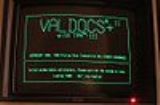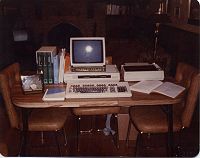
Epson QX-10
Encyclopedia

Microcomputer
A microcomputer is a computer with a microprocessor as its central processing unit. They are physically small compared to mainframe and minicomputers...
running CP/M or TPM-III (CP/M-80 compatible) which was introduced in 1983. It was based on a Zilog Z80
Zilog Z80
The Zilog Z80 is an 8-bit microprocessor designed by Zilog and sold from July 1976 onwards. It was widely used both in desktop and embedded computer designs as well as for military purposes...
microprocessor
Microprocessor
A microprocessor incorporates the functions of a computer's central processing unit on a single integrated circuit, or at most a few integrated circuits. It is a multipurpose, programmable device that accepts digital data as input, processes it according to instructions stored in its memory, and...
, running at 4 MHz, provided up to 256K of RAM organized in four switchable banks, and included a separate graphics processor chip (µPD7220) manufactured by NEC
NEC
, a Japanese multinational IT company, has its headquarters in Minato, Tokyo, Japan. NEC, part of the Sumitomo Group, provides information technology and network solutions to business enterprises, communications services providers and government....
to provide advanced graphics capabilities. In the USA, two versions were launched; a basic CP/M configuration with 64 K RAM and the HASCI configuration with 256 K RAM and the special HASCI keyboard to be used with the bundled application suite, called Valdocs. The European and Japanese versions were like the CP/M configurations. TPM-III was used for Valdocs and some copy protected programs like Logo
Logo (programming language)
Logo is a multi-paradigm computer programming language used in education. It is an adaptation and dialect of the Lisp language; some have called it Lisp without the parentheses. It was originally conceived and written as functional programming language, and drove a mechanical turtle as an output...
Professor.
The machine had internal extension slots, which could be used for extra serial ports, network cards or third party extensions like an Intel 8088 processor, adding MS-DOS compatibility.
QX-16
Its successor, the dual-processor QX-16, added a 16-bit Intel processor enabling it to also boot MS-DOSMS-DOS
MS-DOS is an operating system for x86-based personal computers. It was the most commonly used member of the DOS family of operating systems, and was the main operating system for IBM PC compatible personal computers during the 1980s to the mid 1990s, until it was gradually superseded by operating...
2.11. The case of the QX-16 was enlarged to provide enough physical space for an internal hard-drive in contrast to the QX-10's dual-floppy configuration.
Valdocs

WYSIWYG
WYSIWYG is an acronym for What You See Is What You Get. The term is used in computing to describe a system in which content displayed onscreen during editing appears in a form closely corresponding to its appearance when printed or displayed as a finished product...
framework/OS for document creation and management, written as a set of interactive application and system modules which ran only on Epson's QX-10 and QX-16 computers. A version designed to run on the IBM PC was in development when Rising Star closed in 1986.
Valdocs shipped to beta testers circa late 1982. Beta and initial production releases of Valdocs' application modules were written in the Forth programming language while its system-oriented modules (such as E-Mail and disk utilities) were written in Z-80 Assembly Language
Assembly language
An assembly language is a low-level programming language for computers, microprocessors, microcontrollers, and other programmable devices. It implements a symbolic representation of the machine codes and other constants needed to program a given CPU architecture...
. Later releases of Valdocs' applications were written in the C programming language
C (programming language)
C is a general-purpose computer programming language developed between 1969 and 1973 by Dennis Ritchie at the Bell Telephone Laboratories for use with the Unix operating system....
.

Switching between programs was done by pressing an associated hotkey on the QX-10's keyboard (which was specifically designed to support Valdocs, including an UNDO key) or by selecting a program from a menu the hotkey invoked. The keyboard was referred to as HASCI (Human Application Standard Computer Interface) after the user interface with the same name pioneered by Rising Star Industries.
Valdocs was ahead of its time, but there were three major problems with the QX-10 and QX-16. The computer ran at only 4 MHz and was very slow. Using the TPM system was too complicated for most users, similar to that of raw MS-DOS. Worst of all, Valdocs was written in a forth dialect instead of in assembly language and the system was loaded with bugs that resulted in numerous fatal errors. Users would often spend hours writing a document only to see all of that hard work lost in a system crash. Roger Amidon created a program called QX Cure-all that was designed to recover a lost document, but it worked only about half the time. Amidon created other utility software as well as a bootrom. Even with all of the added improvements, the system was just too slow and flawed to compete with companies such as Apple and Microsoft.
External links
- Valdocs Programming Manual contains a chapter on the theory and philosophy of HASCI
- User's Home Page
- QX-10 User Manual from Epson
- Obsolete Computer Museum Entry
- AtariArchives - Test Driving the QX-10
- AtariMagazines - Qx-10, The Friendliest Computer
- Yet another computer museum
- Why someone chose a QX-10 over an IBM PC

